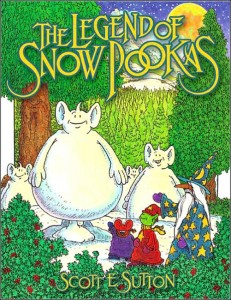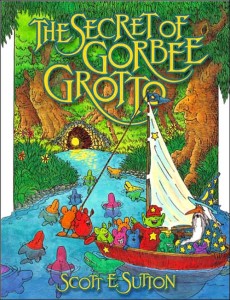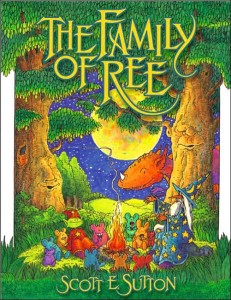Welcome to the Planet Ree,
Which is a very nice place to be.
Share these stories with children,
To teach them about their world they live in.
I apologize for the above, but after reading the first three releases in the Family of Ree series, written and illustrated by Scott Sutton, I found it rather difficult to think in anything but rhyme. That’s because these three books, The Family of Ree, The Secret of Gorbee Grotto, and The Legend of Snow Pookas invoke the spirit of Dr. Seuss in their own whimsical, unique manner, conveying moral messages and educational undertones even as they strive to entertain.
The Planet Ree is a far off place, a beautiful blue and green planet inhabited by a fanciful host of odd creatures who coexist in symbiotic harmony. The Talking Trees give advice to the people who take care of them, and drop acorns. The acorns develop into the landbased BeeBees or seaborne GorBees, which act as minor helpers for the other evolutionary stages. When these grow up, they become Erfs and Sea Erfs, respectively, which aid the next step up on the chain, namely Wizards and Sea Queens, who are responsible for the whole world. And when they get old, you guessed it, they become Talking Trees, thus completing the cycle. Got all that?
Then there are the Long-Legged Ploots, the northern-dwelling Snow Pooka, Spotted Tree Gings, Floating Flying Fingergin, Muppies, and the Flipping Floating Flying Floojies, as a small sampling of the other bizarre beasties populating the world. Fairly fascinating, frequently freaky, fortunately fantastical, is all I have to say. (I promise, no more alliteration.)
Each book in the series is aimed at conveying a different moral lesson. For instance, The Family of Ree is geared towards helping children understand the symbiotic relationship between all aspects of an ecosystem, and how to respect this cycle of nature. (So take care of the planet where you belong, Because it’s what you’re standing on.) It also serves to introduce us to all of these beings that live on Ree, acting as a guided tour over land and sea, showing us how everything comes to be. (I didn’t say I wouldn’t rhyme.)
The Secret of Gorbee Grotto follows the adventures of one particular Erf, Jeeter. When his normal routine is disrupted by the appearance of a mysterious light, he sets off with his master, Dundee the Wizard, to investigate. They journey to Gorbee Grotto, where they discover something most definitely not of the planet Ree: a creature called a Woodrat. The Woodrat and his people turn out to be cosmic exiles, cast adrift after their own planet perished from natural causes, ultimately coming to Ree where they could be of service through their natural calling of forest rangers. The motto of this story? “Try treating others the way you’d want them to treat you.” Especially when facing the unknown. You never know when you’ll make a new friend.
The Legend of Snow Pookas takes us up north, to the frozen wasteslands at the top of Planet Ree, where bizarre three legged people known as the Snow Pookas dwell peacefully. Who are they? What are they? What role do they play in the ecosystem? The Erf Jeeter and the Wizard Dundee are determined to find out. Imagine how surprised our heroes are when they realize that the Snow Pookas do the same things they do, only adapted for the cold. The moral? “Take care of the young ones, that’s how it goes… Respect the old ones and help them with stuff.”
The true strength of these books clearly isn’t in the rhymes, which I found a bit forced, and even difficult to read aloud at times, but in the artwork, which is beautiful. Stylistic and brightly colored, children will adore the whimsical drawings of the imaginative inhabitants of Planet Ree, which tend towards round, friendly curves and bright smiles. By turns goofy and joyful, the drawings stand out on every page, eye-catching without going overboard.
On the flip side, the story portion isn’t as strong. The rhyming scheme is simplistic, and often forced, and the tongue-twisting alliteration is occasionally overboard. I gave it the read-aloud test for good measure, and tripped over my tongue halfway through a recitation of the “Flipping Floating Flying Floojie.” However, properly coached or practiced, a parent could probably turn reading these books out loud into quite the production. I suspect that the younger audience will greatly enjoy the theatrical presentation of their parents gamely reciting some of these stories.
In general, I found The Family of Ree books to be a mixed, but interesting experience. The artwork is strong, the concepts extremely creative, and the morals important. I’ve no doubt that they’ll go over well with children, and the parents had better get used to pronouncing names like Seagoing Splishes and Bobbing Bungalla Bingallees. For more information on Scott Sutton and The Family of Ree, check out their presence on the Web at www.actionpublishing.com.
Thank you for listening to my humble review
I truly hope that I’ve managed to help you,
Telling you all about the Planet Ree
And the wonderful things you’ll see.
(Sorry, couldn’t resist. Done now. Honest.)



